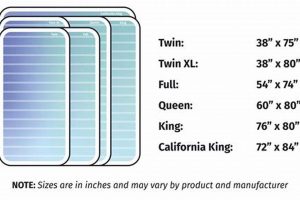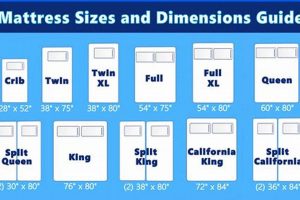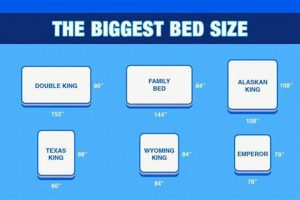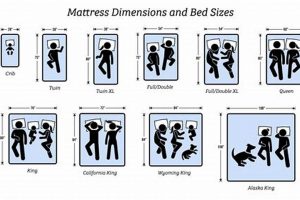The dimensions of sleeping surfaces designed for recreational vehicles and trailers vary considerably, dictated by the available space within these mobile living quarters. Examples range from compact cots suited for single occupants to wider platforms intended for couples or families. Understanding these size variations is crucial for ensuring comfortable rest while traveling.
Properly sized sleep surfaces enhance the overall living experience in RVs and trailers. Choosing appropriate dimensions contributes to efficient space utilization, maximizing comfort during travel, and potentially increasing the resale value of the vehicle. Historically, space constraints have driven innovation in mattress designs to accommodate the unique challenges of RV living.
The ensuing sections will delve into specific measurements commonly encountered in the recreational vehicle industry, offering guidance on how to select the most appropriate option for individual needs and vehicle layouts. Factors such as mattress type, construction materials, and compatibility with existing RV platforms will be explored.
Considerations for RV Trailer Mattress Selection
Choosing a mattress for a recreational vehicle requires careful assessment of available space and individual comfort preferences. Prioritizing correct measurements and material quality ensures optimal rest while on the road.
Tip 1: Measure the Available Space Accurately: Precise measurements of the RV’s designated sleeping area are paramount. Allow for any protrusions or obstructions within the space to prevent purchasing a mattress that does not fit.
Tip 2: Prioritize Lightweight Materials: Select mattresses constructed from materials that minimize added weight to the trailer. Excessive weight can negatively impact fuel efficiency and overall vehicle handling.
Tip 3: Consider Mattress Thickness: Evaluate the headroom within the RV, particularly in bunk areas or lofted spaces. A thicker mattress might compromise headroom, leading to discomfort.
Tip 4: Evaluate Support and Firmness: Assess individual sleep preferences regarding mattress firmness. Options range from plush memory foam to firmer innerspring models, each offering varying levels of support.
Tip 5: Research Mattress Material Breathability: Opt for materials that promote airflow and minimize heat retention. Poor ventilation can result in uncomfortable sleeping conditions, especially in warmer climates.
Tip 6: Inquire About Mattress Warranty: Investigate the manufacturer’s warranty coverage for defects or premature wear. A comprehensive warranty provides assurance of product quality and durability.
Tip 7: Assess Compatibility with Existing Platform: Confirm that the selected mattress type is compatible with the existing bed frame or platform within the RV. Some platforms may require specific mattress constructions.
Careful consideration of these factors will contribute to selecting a mattress that maximizes comfort, optimizes space utilization, and enhances the overall RV travel experience. Precise measurements, material selection, and warranty evaluation are crucial steps in the purchasing process.
The following section will provide an overview of common mattress types available for RVs, allowing for a more informed purchasing decision.
1. Length
Length, as a fundamental dimension, directly dictates the suitability of a recreational vehicle or trailer mattress within a given sleeping area. An incorrect length selection invariably results in either a mattress too large to fit or a mattress too short, creating unused and potentially unusable space. The available length often determines whether a standard mattress configuration, such as a queen or king, can be accommodated, or if a specialized, shorter RV-specific size is required. In scenarios where available length is limited, custom-sized mattresses become a necessity.
The consequence of miscalculating the length extends beyond mere inconvenience. A mattress that is too long may necessitate modifications to the RV’s interior, such as removing trim or altering the bed frame, actions that can compromise structural integrity. Conversely, a mattress that is too short leaves a gap that can become a repository for debris and may lead to discomfort or injury due to shifting during sleep. Real-world examples include instances where RV owners purchase standard mattresses only to discover they protrude into walkways or block storage compartments, necessitating costly replacements.
Accurate measurement of the available length and careful consideration of this dimension’s impact are paramount. Choosing the correct length is not merely a matter of convenience; it is integral to ensuring a comfortable and functional sleeping environment within the RV. Accurate assessment of length also has an impact on safety and structural integrity. Ignoring this parameter leads to a domino effect of negative outcomes, from compromised comfort to costly rectifications. A comprehensive understanding of length constraints is crucial for a successful RV mattress purchase.
2. Width
Width, in the context of recreational vehicle and trailer sleep surfaces, represents the lateral dimension of the mattress. This dimension is pivotal in determining the sleeping capacity and overall comfort level within the confines of an RV. An inadequate width can compromise sleeping comfort, while an excessive width may impede movement within the RV interior.
- Occupancy Requirements
The required width is directly influenced by the intended occupancy of the sleeping area. A single occupant requires less width than a couple or family. Standard width designations, such as “twin,” “full,” or “queen,” are often adapted for RV applications to maximize space utilization. Examples include short queen mattresses, which maintain the standard queen width but reduce the length. Failing to consider occupancy requirements can lead to discomfort and overcrowding.
- Interior Layout Constraints
The interior architecture of the RV dictates the maximum allowable width. Wheel wells, cabinetry, and other fixed features can restrict the available space. Precise measurement of the available width between these obstructions is crucial. Ignoring these constraints can result in a mattress that cannot be properly installed, necessitating alterations to either the mattress or the RV’s interior.
- Accessibility and Maneuverability
The width of the mattress can impact accessibility within the RV. An overly wide mattress may obstruct pathways, making it difficult to navigate the vehicle. It can also hinder access to storage compartments or other essential features. Consideration of the overall floor plan and traffic flow is essential when selecting a mattress width. Practical examples include instances where excessively wide mattresses block access to emergency exits or utility panels.
- Weight Distribution
Width, in conjunction with length and mattress material, contributes to the overall weight distribution within the RV. Uneven weight distribution can affect the vehicle’s handling and stability. Care should be taken to ensure that the chosen mattress width does not exacerbate existing weight imbalances. In extreme cases, improper weight distribution can compromise safety and increase the risk of accidents.
These factors highlight the complex interplay between width and overall functionality within an RV environment. Careful consideration of occupancy requirements, layout constraints, accessibility, and weight distribution is crucial for selecting a mattress with appropriate dimensions. Selecting the right width maximizes both comfort and utility, contributing to a more pleasant and safe travel experience.
3. Thickness
Thickness, as a dimension of recreational vehicle and trailer mattresses, significantly influences comfort, headroom, and overall space utilization. A mattress that is too thick can impede movement within the vehicle, obstruct access to overhead compartments, or reduce headroom in bunk areas. Conversely, a mattress that is too thin may lack sufficient support, leading to discomfort and potentially affecting sleep quality. The correlation between thickness and the suitability of a specific mattress size within an RV setting is therefore paramount.
The selection of mattress thickness is often dictated by the specific layout of the recreational vehicle. In pop-up campers or trailers with low ceilings, a thinner mattress is essential to maintain adequate headroom. Conversely, in larger RVs with more vertical space, a thicker mattress may be preferable for enhanced comfort. Examples include bunk beds, which typically require thinner mattresses to comply with safety regulations and prevent occupants from hitting the ceiling. In master suites, a thicker mattress may be chosen to provide a more luxurious sleeping experience. The weight of the material contributing to the thickness must also be considered to avoid exceeding weight limits.
In summary, mattress thickness is a critical factor in determining the suitability of an RV or trailer mattress. Consideration of available headroom, intended use, and weight limitations is essential for selecting a mattress that optimizes comfort and functionality. Misjudging thickness can lead to compromised comfort and restricted maneuverability, highlighting the need for careful evaluation of this dimension within the broader context of available space and user needs.
4. Custom Dimensions
The prevalence of non-standard sleeping spaces within recreational vehicles and trailers necessitates the consideration of custom dimensions when selecting a mattress. Variations in floor plans, structural limitations, and space-saving designs often preclude the use of pre-fabricated, standard-sized mattresses. Therefore, understanding the role of custom dimensions is crucial for achieving optimal fit and comfort.
- Irregularly Shaped Sleeping Platforms
Many RVs feature sleeping platforms that deviate from conventional rectangular or square shapes. Angled corners, wheel well intrusions, and built-in cabinetry can create unique spatial constraints. In these situations, custom-sized mattresses are essential to maximize usable sleeping area and avoid gaps or overhangs. Ignoring these irregularities leads to inefficient space utilization and reduced comfort.
- Space Optimization in Compact RVs
In smaller RVs and trailers, every inch of space is valuable. Custom dimensions allow for precise tailoring of the mattress to the available area, ensuring no space is wasted. This often involves reducing the length or width of a standard mattress size or creating a mattress with a unique profile to fit around existing fixtures. Optimizing dimensions in this manner can significantly enhance the functionality of the RV’s interior.
- Accommodation of Unique Bedding Mechanisms
Some RVs utilize innovative bedding mechanisms, such as fold-out sofas or convertible dinettes, that require mattresses with specific dimensions and folding capabilities. These mattresses must be designed to fit the contours of the folded-out bed and to be easily stored when not in use. Standard mattress sizes are generally incompatible with these mechanisms, necessitating custom solutions.
- Addressing Individual Comfort Preferences
Beyond spatial constraints, custom dimensions can also cater to individual comfort preferences. RV owners may opt for a mattress with a specific length or width to better accommodate their body size or sleeping habits. For example, taller individuals may require a longer mattress than what is typically offered in standard RV sizes. Customization, in this context, directly contributes to improved sleep quality and overall satisfaction.
In conclusion, custom dimensions are integral to the successful integration of a mattress into the unique environment of an RV or trailer. By addressing spatial limitations, accommodating specialized bedding mechanisms, and catering to individual comfort needs, custom-sized mattresses offer a tailored solution that maximizes both functionality and comfort. The ability to specify precise dimensions is an essential consideration for any RV owner seeking an optimal sleeping experience.
5. Corner Radius
Corner radius, in the context of recreational vehicle and trailer mattresses, refers to the degree of curvature applied to the corners of the mattress. This seemingly minor detail is often critical for proper fit within RVs that feature sleeping platforms with rounded corners. Failure to account for corner radius can result in a mattress that either overhangs the platform, creating a tripping hazard, or leaves a significant gap, reducing usable sleeping space and potentially causing discomfort. The influence of corner radius on the overall dimensions of a mattress necessitates careful consideration during the selection process.
The necessity for precise corner radius measurements stems from the design of many RV sleeping platforms. Manufacturers frequently incorporate rounded corners to maximize interior space, improve aesthetics, or comply with safety regulations. A mattress with square corners will not conform to this curved edge, leading to the aforementioned issues. Conversely, a mattress with a corner radius that is too large will not fully occupy the available space, resulting in a less stable and comfortable sleeping surface. A practical example is found in older RV models, where the corner radius was often a more pronounced curve, requiring specialized mattresses or custom modifications. The absence of standardized corner radii across different RV manufacturers and models further compounds the need for meticulous measurement and accurate specification of corner radius during mattress selection.
In summary, corner radius is an essential dimension of RV and trailer mattresses, particularly when dealing with non-rectangular sleeping platforms. Inaccurate assessment of corner radius will lead to fitment problems, compromising both comfort and safety. The lack of standardization in corner radius design necessitates careful measurement and consideration of this parameter to ensure optimal mattress integration and overall satisfaction. A clear understanding of corner radius is essential for those seeking to replace or upgrade their RV mattress and provides benefits for safety and structural support and prevent potential hazards.
6. Platform Compatibility
Platform compatibility, a crucial consideration in recreational vehicle mattress selection, directly impacts the suitability and performance of the chosen sleep surface. Mismatched platform and mattress dimensions or construction types can lead to instability, reduced comfort, and premature wear. The correlation stems from the necessity for the mattress to be adequately supported by the underlying structure, ensuring even weight distribution and preventing sagging or deformation. Consider an instance where a memory foam mattress, designed for a solid, flat platform, is placed on a slatted base with wide gaps. The mattress may sink between the slats, compromising its support and potentially damaging the foam structure. Conversely, an innerspring mattress may exert excessive pressure on a weaker platform, causing structural damage over time. Therefore, precise dimension matching and material compatibility are paramount for optimal performance.
The importance of platform compatibility extends beyond mere comfort considerations. An unstable or poorly supported mattress can shift during sleep, creating discomfort and potentially posing a safety hazard, particularly in moving vehicles. Furthermore, a mismatched mattress and platform can accelerate wear and tear on both components. The platform may suffer from stress fractures or warping, while the mattress may experience uneven compression and reduced lifespan. This can be readily observed where the mattress is not the exact sizes with the platform, there are additional friction on the edge of it, causing wear and tear earlier than expected.
In conclusion, platform compatibility is intrinsically linked to the selection of appropriate recreational vehicle mattress dimensions. Ensuring a proper fit and compatible construction materials prevents instability, maximizes comfort, and prolongs the lifespan of both the mattress and the platform. Addressing this consideration is essential for RV owners seeking a safe, comfortable, and durable sleeping solution, and for proper RV up-keeping and reducing unnecessary repair expenses.
Frequently Asked Questions
The following questions address common inquiries regarding the selection and utilization of appropriately sized mattresses for recreational vehicles and trailers.
Question 1: What constitutes a standard RV queen mattress size?
The term “RV queen” is not uniformly defined. Generally, it refers to a mattress measuring approximately 60 inches in width, but length variations exist. A standard queen is typically 80 inches long, while a “short queen” may measure 75 inches. Precise measurements are necessary to ensure proper fit.
Question 2: How does mattress thickness affect headroom in an RV?
Mattress thickness directly impacts headroom, particularly in bunk areas or lofted spaces. A thicker mattress reduces the vertical distance between the sleeping surface and the ceiling. Consideration should be given to occupant height to prevent discomfort or restricted movement.
Question 3: Are custom-sized mattresses required for all RVs?
Custom-sized mattresses are not universally required; however, their necessity depends on the specific layout and dimensions of the RV’s sleeping area. Irregularly shaped platforms or space constraints may necessitate custom dimensions to maximize usable space.
Question 4: Can a standard residential mattress be used in an RV?
A standard residential mattress can be utilized in an RV if the dimensions align with the available space. However, considerations should be given to weight, flexibility for maneuvering within the space, and thickness, as these factors can impact fuel efficiency and interior space utilization.
Question 5: What factors influence the selection of mattress firmness for an RV?
The selection of mattress firmness is subjective and depends on individual sleep preferences. Factors to consider include sleeping position, body weight, and any pre-existing back or joint conditions. Both memory foam and innerspring options are available in varying firmness levels.
Question 6: How does platform construction influence the choice of RV mattress?
Platform construction influences mattress selection. Solid platforms provide uniform support for most mattress types. Slatted platforms require consideration of slat spacing to prevent sagging or deformation of the mattress, especially for memory foam models.
Careful consideration of dimensions, thickness, and platform compatibility is essential for optimizing comfort and functionality within the confined space of an RV. Accurate measurements and thorough research are recommended prior to purchase.
The subsequent section provides a summary of key considerations for selecting an appropriately sized RV mattress.
Recreational Vehicle Mattress Dimensions
The preceding discussion has addressed the multifaceted considerations surrounding the selection of appropriately sized sleep surfaces for recreational vehicles and trailers. Key areas of focus have included length, width, thickness, the importance of custom dimensions, corner radius specifications, and platform compatibility. The objective understanding of these parameters is imperative for optimizing comfort, safety, and spatial efficiency within the constraints of mobile living environments.
The pursuit of informed decision-making regarding RV trailer mattress sizes should not be underestimated. Careful assessment of individual needs, coupled with precise measurement and a thorough comprehension of available options, will contribute significantly to the overall travel experience. Adherence to these principles ensures a restful and secure environment, promoting well-being and enhancing the value of recreational pursuits.







